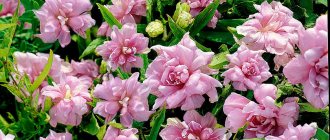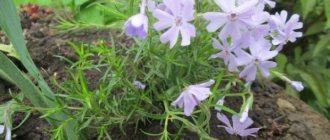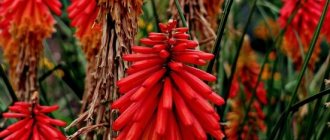Author: Elena N. https://floristics.info/ru/index.php?option=com_contact&view=contact&id=19 Category: Garden plants Published: January 27, 2019Last edits: January 13, 2021
- Planting tubers
- Anemone blanda
Anemone, like all proud beauties, requires special treatment. Therefore, no general recommendations, no universal advice! Almost each of the 160 (!) varieties of anemone has its own requirements for watering, soil, light... But don’t rush to give up whims! A certain formula for success in growing anemones (even if you don’t know the variety exactly!) still exists: plant in partial shade, organize drainage, as they grow, fertilize and loosen – half the battle is done!
- Why is the anemone afraid of weeding?
- How to organize continuous flowering of anemone on your site from April to November?
- How to wake up “lazy” flower seeds?
- How to organize proper wintering for a plant?
Read about all this in our article.
Planting and caring for anemones
- Planting: sowing fresh seeds for seedlings in June-July or before winter (October-November) in boxes. Planting tubers in spring.
- Flowering: spring, summer or autumn - depending on the species.
- Lighting: for forest species - partial shade, for Mediterranean species - bright sunlight.
- Soil: loose, fertile, (sandy or peat), preferably neutral.
- Watering: only in dry times and during the flowering period.
- Fertilizing: liquid organic and mineral fertilizers during the flowering period and in autumn.
- Reproduction: seed and vegetative (tubers, dividing the bush or parts of the rhizome).
- Pests: Leaf nematodes, aphids, South American leaf miners, thrips and whiteflies.
- Diseases: gray rot, peronosporosis (downy mildew), anthracnose, sclerotinia, viral infections.
Read more about growing anemones below.
The name of the plant anemone (lat. Anemone) , or anemone from Greek, is literally translated as “daughter of the winds,” since anemone flowers react by fluttering their petals even to the weakest gust of wind. The flower belongs to the buttercup family and is a perennial herbaceous plant. It is found in temperate climates on the plains and mountainous regions of both hemispheres. There are about 160 species, blooming at different times and in very different ways, which confuses even experienced gardeners. How to grow anemones will be discussed in this article.
Off-season forcing of anemones at home
The plant is one of those that can be forced at home outside the warm season, because their tubers remain viable even during the dormant period. They can be planted at home from September to December, flowering will occur in about 2 months. Pots should be no more than 15 cm in diameter; sandy soil with good drainage is preferable. You can use ready-made soil mixtures for flower crops. During the germination stage, it is important to keep the containers indoors no higher than +12C, and after budding they can be moved to a warm place.
In winter, the plant is easy to flood, because... their growth slows due to lack of sunlight.
After flowering, you need to wait for the foliage to dry, dig up the tuber, clean it from the ground and put it in storage until planting again.
Features of cultivation
Among the variety of species and varieties of anemones, there are some that are completely unpretentious, and there are those that require special care, and this difference is explained by the fact that some anemones have rhizomes, while others have tubers. Species with rhizomes are easy to grow, but mistakes in caring for tuberous anemones lead to serious consequences.
- Honeysuckle honeysuckle: planting and care, description of varieties
There are a few things to consider if you are interested in growing anemones.
- Firstly, these flowers require mandatory watering in dry, hot weather.
- Secondly, autumn fertilizing should be carried out with complex mineral fertilizers, and the soil should be fertilized before planting or during growth and flowering - with organic fertilizers.
- Thirdly, in winter, protect the anemones from frost by covering them with dry leaves.
- And lastly: it is best to propagate anemones in the spring by root suckers or seeds sown closer to winter. We will dwell on all these features in more detail below.
General recommendations
Flowering of hybrid anemones begins in late summer and continues until frost. These amazing delicate flowers will decorate a small garden and estate. They can be used to create wonderful compositions in combination with other perennials: ornamental grasses, hostas, rhododendrons, hydrangeas, roses. They will look great against the background of trees or shrubs. They can be used to decorate rock gardens and alpine slides. Against the background of a green lawn, a single overgrown anemone bush will also look elegant.
To maintain a neat appearance of the flower garden in the fall, faded stems must be carefully removed and dry leaves removed from under the bush. Just before frost, cut off the above-ground part, leaving 15-20 centimeters of basal leaves. Despite the fact that hybrid anemones are generally frost-resistant, it is still better to cover them for the winter. To do this, use spruce spruce branches or a special covering material, for example, spunbond.
Preparing to plant anemones
Soil preparation
Before planting anemones, you need to choose a planting site and prepare the soil. The area will need to be spacious, shaded and protected from drafts. The rhizomes of anemones grow greatly during the season, but are so fragile that they are damaged by contact, and this must be taken into account. In addition, anemones do not tolerate extreme heat and drafts.
The soil is well-drained, loose and fertile. Loam or deciduous soil with peat is best. To create an ideal structure, add simple sand to the soil, and you can reduce excessive acidity, which is harmful to anemones, by adding dolomite flour or wood ash to the soil.
Seed preparation
Those who decide to grow flowers from seeds should know that anemone seeds have low germination rate: no more than a quarter germinates, and only from freshly collected seeds. But if you subject the seeds to stratification, that is, expose them to cold for 1-2 months, you can increase their germination. To do this, the seeds are mixed with coarse sand or peat at the rate of 1 part seeds to three parts sand, well moistened and sprayed with water daily to maintain the required humidity.
When and how to sow asters - advice from experienced gardeners
As soon as the seeds swell, add a little substrate, mix, moisten and place in a ventilated room with a temperature no higher than 5 ºC. A few days later, when the sprouts hatch, the container with the seeds should be taken out into the yard, buried in the snow or soil and sprinkled with sawdust or straw. In early spring, the seeds are transplanted into boxes for germination.
- indoor azalea
But to save yourself from all this hassle, it is better to plant the seeds in autumn in boxes with loose soil and bury them in the yard, covering them with cut branches. Over the winter they will undergo natural freezing, and in the spring you will dig them up and plant them.
In the photo: planting anemone seeds for seedlings in trays
Tuber preparation
Before planting, anemone tubers are awakened from sleep by soaking in warm water for several hours to swell, and then planted to a depth of 5 cm in pots with a damp mixture of peat and sand for germination. The soil in pots should be moistened moderately but regularly.
Some gardeners recommend “soaking” the anemone bulbs by wrapping them in a cloth well moistened with an epin solution and keeping them in a plastic bag for about six hours. After this, anemones can be immediately planted in the ground.
In the photo: Preparing anemone tubers for planting
Planting prepared tubers in the ground
You can plant anemone tubers permanently as soon as they take root and form growing points. By this time it will be difficult to confuse where is up and where is down. When planting, the tuber is buried in pots (for growing) or in open ground to two of its heights, but not more than 5 cm. The desired temperature at this stage is not higher than +12C, only in such conditions will the sprouts be strong. Further increases in temperature will no longer harm them. The time to transfer the grown tubers to the garden will come when the street temperature becomes equal to the room temperature. In the first days, it is advisable to shade the young shoots.
Planting anemones
Planting tubers
Planting an anemone does not involve any special difficulties; the main thing is to determine the growth point. Pre-processed, swollen tubers have visible bud tubercles, and it is clear how to plant them. But if in doubt, remember: the top of the anemone tuber is flat, so you need to plant it with the sharp end down. If you are confused by the shape of the tuber, plant it on its side. The hole for the anemone should be 30-40 cm in diameter and 15 cm deep. Pour a handful of humus and ash into the bottom of the hole, then place the tuber, sprinkle it with soil and lightly press it down. Water the place where the anemone flowers are planted well.
In the photo: Anemone seedlings ready for transplanting into the ground
Planting seeds
By the time of planting, anemone seedlings must have at least two leaves. Seedlings are planted in the ground in a slightly shaded place in the second year of growth. If planting is carried out in the fall, the sown area is covered with branches or leaves from frost. Anemones grown from seeds will bloom only after three years.
Expert advice on growing freesia in open ground
As for the timing of planting tubers or seeds, you can ensure that anemones will bloom on your site from April to November if you purchase different varieties and plant them at the optimal time for each of them.
Planting in spring in open ground
You can plant anemones in the spring either by seeds in open ground or by seedlings. Direct planting in open ground in the fall is also practiced. According to the well-established opinion of gardeners, only seed collected in the current season is suitable for autumn sowing. Seedlings are planted in early spring. In both cases, an important rule must be observed: the seeds should not be buried too much due to the fragility of the sprouts, which may not reach the surface. It is enough to simply sprinkle them with earth, preferably through a sieve. At home, you can even leave them on the surface, lightly pressing them against the surface of the soil and moistening them.
Autumn crops will sprout immediately after the snow melts, but here they will face a serious test from the soil oversaturated with moisture. Overwatering can destroy the seedlings completely. Therefore, you should not choose low-lying places for this method of reproduction.
Anemone planted with seeds will produce buds only in the third year!
Anemone care
Caring for anemone is simple and not burdensome. The main problem in this matter is maintaining the required level of humidity throughout the entire growing season. The danger is that if overwatered, the root system may die from rot. And the lack of moisture, especially during the formation of buds, does not contribute to the growth and flowering of anemone. To balance the humidity level, plants should be planted at a higher elevation in an area with good drainage.
- How to care for greenhouse watermelons
After planting, it is very advisable to mulch the area with a five-centimeter layer of foliage from fruit trees or peat. As for watering, in the spring it is enough to moisten the soil once a week; in moderate summers, the anemone does not need additional watering, the only exception being the crown anemone during the flowering period. During hot, dry summers, water daily in the morning or after sunset.
It is advisable to feed anemones during flowering with liquid organic matter (anemones do not like only fresh manure) and complex mineral fertilizers in the autumn. If you fertilized the bed before planting the anemone, then fertilizing can be omitted altogether. It is also recommended to regularly loosen the soil and pull out weeds. Or rather, do not weed, but dig through it with your hands, since you can damage the fragile root system of the anemone with a hoe.
Anemones are disease resistant; Sometimes they are harmed by slugs and snails, but a solution of metaldehyde will help you deal with these pests, which must first be collected by hand. Some anemones suffer from winter cutworm (cutworm caterpillar) or leaf nematode. When affected by a nematode, it is better to destroy the diseased plants and replace the soil in which they grew.
How to grow beautiful ranunculus at home and in the garden
Pest and disease control
Anemones are fully adapted to the changeable continental climate and northern cold. They are almost not susceptible to disease if you follow the rules of care. The most common pest is the leaf nematode, which leaves yellow-brown spots on the leaves. Here it is important to remove the affected plants in a timely manner and replace the soil.
Photo: vitusltd.ru
Purslane (80 photos): types, reproduction and care
Anemone after flowering
In the climate of the middle zone, with the onset of autumn, anemones need to be removed from the soil and prepared for winter storage: dry the tubers, cut off the tops (the above-ground part of the bush) and store them in the dark and cool, placing them in peat or sand. A damp basement is best suited for this.
In the photo: Growing anemones in a flower bed
If you decide not to dig up anemones in anticipation of a warm winter, cover the area with fallen leaves or spruce branches so that unexpected frost does not destroy the flowers.
How to grow anemones from tubers by division
It is best to carry out the procedure in the spring. To do this, tubers dug up in the fall are taken or those that have overwintered are dug up. Using a sharp knife, they are cut into pieces so that each one contains the lower, horse part, and at least one kidney. The cut is sprinkled with wood ash. The resulting planting material is placed in the hole in a horizontal position and sprinkled with a layer of soil no more than 5 cm. The soil is moistened and slightly compacted. Young seedlings obtained in this way will become full-fledged adult plants only in the third year.
Anemone species
Since the anemone flower is presented in great variety in culture and nature, and different types require different care, let's get acquainted with at least the most common representatives of the anemone family.
Types and features of caring for anemones. Based on the time of flowering, anemones are divided into spring and summer (or autumn). Spring anemones are very elegant, in a wide range of pastel shades: snow-white, cream, pink, blue, lilac... There are even double varieties. Spring anemones are ephemeroids, that is, their above-ground flowering cycle is short: waking up in April, they bloom in May, and in July they already retire, although in many species the leaves remain until autumn. Anemones differ in the type of rhizome. In the buttercup and oak anemones the rhizome is jointed and fragile, while in the tender anemone it is tuberous and slowly growing.
Anemone blanda
This plant is miniature, 5-10 cm in height, the most popular varieties are Blue Shades (blue), Charmer (pink), White Splendour (white).
In the photo: Tender Anemone (Anemone blanda)
Oak anemone (Anemone nemorosa)
Not so popular in our latitudes, the height of the bush is 20-30 cm, the diameter of the flower is 2-4 cm, the flowers are usually simple white, but in cultivation there are varieties with blue, lilac and pink flowers. There are even terry specimens. The main advantage is unpretentiousness.
In the photo: Anemone nemorosa
Anemone ranunculoides
It is also unpretentious, also has double varieties, the height of the bush is 20-25 cm, the flowers are bright yellow, slightly smaller than those of the oak anemone, and grows in almost any soil.
In the photo: Anemone ranunculoides
Summer-blooming (autumn) anemones are represented by such species as Japanese anemone (Anemone japonica), hybrid anemone (Anemone hybrida) and crown anemone (Anemone coronaria). As a rule, these are large perennials, whose powerful root system is well branched. They bloom from late summer to mid-autumn.
In the photo: Japanese Anemone (Anemone japonica)
Crown anemone (Anemone coronaria)
It blooms twice - in early summer and autumn. The peduncles of autumn species are strong and slender, from 80 cm to one and a half meters high, bearing up to several dozen simple or semi-double flowers of different shades. The most popular varieties of crown anemone are De Caen anemone, which has simple single flowers of a variety of colors, Mister Focker - blue flowers; terry anemone varieties Don Juan (bright red), Lord Jim (blue flowers).
In the photo: Crown Anemone (Anemone coronaria)
Hybrid anemone (Anemone x hybrida)
Known for such varieties as Honorine Jobert with white flowers, slightly pinkish below, semi-double dark purple anemone Profusion, Queen Charlotte, also a semi-double anemone of juicy pink color. Japanese anemone is most often represented in cultivation by such species as Pamina, with large dark pink, almost burgundy double flowers, Hadspen Abundance - a tall anemone with cream flowers, and Prinz Heinrich with semi-double bright pink flowers.
In the photo: Hybrid anemone (Anemone hybrida)
Classification according to flowering time and shape of the root system
It is, of course, impossible to describe and even list all one and a half hundred species of anemone. But it is convenient to divide them into groups according to their main distinguishing features. We will talk about cultivated anemones and those of their natural varieties that are involved in the creation of numerous hybrids.
Early flowering rhizomatous
Before everyone else, immediately after the snow melts, the buds of the ephemeral anemone open. They have a very short life cycle - immediately after the color fades, the plant itself dries out.
Dubravnaya
The flowers are usually white, but can be pink, beige, lilac or have a greenish tint. They grow in the wild, but also have several garden forms. In height - no more than 10 cm.
Lutichnaya
A taller species, reaching 25cm. The petals are yellow in color; double varieties are grown in cultivation.
Altai
The bud has from 8 to 12 petals, white inside and with a slightly bluish tint outside. Reaches 15 cm. A fairly ordinary variety.
Tuberous mid-early anemones
These species also bloom in the spring, but later, and also have a short growing season. These are the most beautiful varieties among anemones.
crown
The most popular and spectacular, also the most capricious in relation to growing conditions. Planting and caring for it is also far from the easiest. The flowers are similar in shape to poppies, but can be of different colors, both bright and muted tones, including two-tone ones. Up to 45 cm in height. There are simple and terry varieties of garden forms. This species is used as a forcing plant indoors.
Tender (Blanda)
Cold-resistant and tolerant of lack of moisture. It grows up to 15cm, has a large number of cultural forms of various colors.
Sadovaya
Large-flowered species, up to 5-6 cm in diameter, 15-30 cm high. It stands out among other varieties with its openwork foliage and has a large color palette. The tubers of this anemone should be dug up for the winter.
Caucasian
The flowers are light blue, plant height up to 20cm. Cold-resistant, light-loving species that prefers moderate moisture. Apennine
Produces single dark blue buds no more than 3 cm in diameter. One of the most cold-resistant varieties of the tuberous variety, which can overwinter in the ground.
Crown anemone, like other varieties whose tubers must be dug up in winter, begin to bloom in the garden later than their close relatives in natural conditions.
Autumn anemones
Anemones, which bloom buds in August-September, are classified as a separate group. All its representatives are rhizomatous and tall. Flowers of autumn varieties form looser clusters of inflorescences and have “splayed” shoots. Once the plant has taken root, caring for it will no longer be difficult.
Japanese
The average height is 80cm, but some varieties of this variety reach 130cm. Some roughness of the pinnately dissected foliage is compensated by elegant pastel inflorescences, which can be either simple or double in shape.
Hybrid
Stems are medium or tall, up to 120cm. It produces numerous root layers, thanks to which it grows very quickly. The flowers are semi-double, up to 6 cm, in shades of pink to deep crimson, with a bright yellow core. Blooms at the end of summer and continues flowering for a month, prefers partial shade. It is not a winter-hardy species and requires shelter for the winter. Looks great in compositions with ornamental cereals, hydrangea, rhododendron and other spherical plants.











